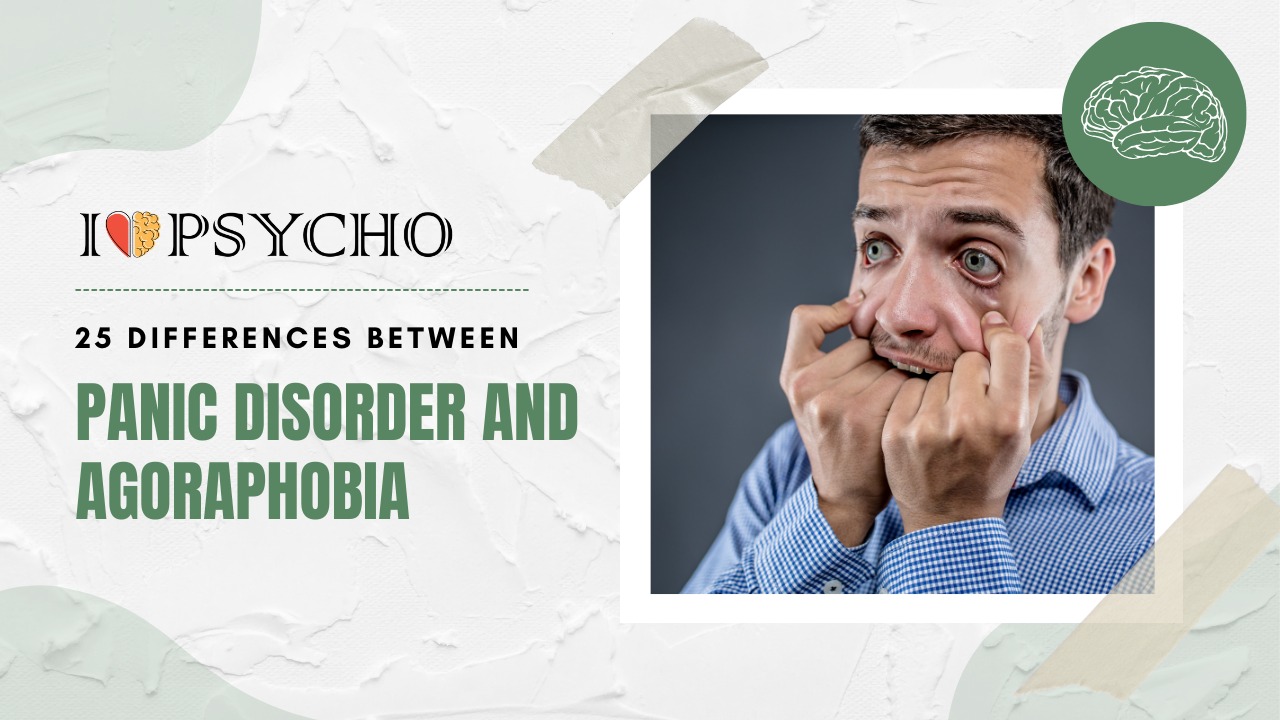Panic Disorder and Agoraphobia are related mental illnesses. Each has symptoms and issues. Even though they typically live together, it’s crucial to identify their fundamental distinctions. Panic Disorder causes frequent, unexpected panic episodes. Panic attacks are strong periods of fear or discomfort accompanied by physical symptoms including a rapid heartbeat, shortness of breath, shivering, and a sensation that horrible things are going to happen. These attacks usually last a few minutes, but the prospect of another may be terrifying. Panic Disorder is largely a dread of panic’s bodily symptoms.
Agoraphobia, on the other hand, is a dread of circumstances or locations where it may be difficult to escape or obtain help if you have a panic attack or a lot of stress. Agoraphobics dread crowds, open spaces, public transit, and other circumstances where they feel trapped and can’t escape. This dread might prevent a person from routine activities including socializing. Isolation and a worse quality of life might result.
Agoraphobia is avoiding places and circumstances, whereas Panic Disorder is experiencing panic episodes. However, these illnesses commonly coexist. Panic Disorder causes Agoraphobia. Agoraphobia can result from the dread of public panic attacks. Panic Disorder and Agoraphobia are treated with psychotherapy, medication, or both. CBT helps patients understand and manage their anxious thoughts, actions, and emotions. To relieve symptoms and aid recovery, SSRIs or antihistamines may be prescribed.
Panic Disorder is characterized by frequent panic episodes and the fear of more, whereas Agoraphobia is a fear of places where it’s hard to escape. Panic Disorder commonly causes Agoraphobia. Treatments address the anxieties and actions that cause both diseases. To promote health and restore everyday chores and social interaction.
Also Read: A Brief History of The Counseling Process and Its Stages
|
S.No. |
Aspects |
Panic Disorder |
Agoraphobia |
|
1 |
Primary Diagnosis |
Characterized by recurrent panic attacks |
Characterized by fear of specific situations or places |
|
2 |
Core Symptom |
Sudden, intense fear with physical symptoms |
Anxiety or panic triggered by certain situations or places |
|
3 |
Triggers |
Panic attacks can be triggered spontaneously or by specific stimuli |
Triggered by specific situations or environments |
|
4 |
Fear Focus |
Fear is primarily focused on the panic attacks themselves |
Fear centers around the inability to escape or get help |
|
5 |
Diagnostic Criteria |
Diagnosis based on the presence of recurrent panic attacks |
Diagnosis based on avoidance of specific situations |
|
6 |
Comorbidity |
Can co-occur with Agoraphobia or other anxiety disorders |
Often co-occurs with Panic Disorder or other anxiety disorders |
|
7 |
Treatment |
Treatment includes exposure therapy and cognitive-behavioral therapy |
|
|
8 |
Prognosis |
Many individuals can lead normal lives with treatment |
Improvement can be achieved with therapy and support |
|
9 |
Fear Source |
Fear originates from the experience of panic attacks |
Fear stems from specific environmental triggers |
|
10 |
Avoidance Behavior |
Avoidance is related to situations where panic attacks occurred |
Avoidance is linked to specific phobic situations or places |
|
11 |
Prevalence |
Prevalence varies but is relatively common |
Prevalence varies, often associated with Panic Disorder |
|
12 |
Panic Attack Timing |
Panic attacks can occur unexpectedly at any time |
Panic or anxiety is linked to specific situations or places |
|
13 |
Diagnostic Criteria |
Diagnosis requires recurrent panic attacks |
Diagnosis focuses on avoidance behavior |
|
14 |
Physical Symptoms |
May experience physical symptoms during panic attacks |
Physical symptoms may arise in feared situations |
|
15 |
Fear of Embarrassment |
Fear is more about the physical sensations during panic attacks |
Fear may include embarrassment in public situations |
|
16 |
Role of Catastrophic Thoughts |
Catastrophic thoughts about health or danger may be present |
Catastrophic thoughts about safety and escape may be present |
|
17 |
Agoraphobic Situations |
No specific aversion to certain situations or places |
Aversion to specific situations, e.g., crowded spaces or public transit |
|
18 |
Social Interaction Anxiety |
Social anxiety may be present but not a primary focus |
Social situations may be avoided due to agoraphobic fears |
|
19 |
Impact on Daily Life |
May affect daily life due to panic attacks |
Can significantly limit daily activities due to avoidance |
|
20 |
Typical Age of Onset |
Can onset in adolescence or adulthood |
Often begins in late adolescence or early adulthood |
|
21 |
Gender Predominance |
Can affect both genders equally |
More prevalent in women than men |
|
22 |
Cognitive-Behavioral Factors |
Focus on managing panic-related thoughts and behaviors |
Focus on changing avoidance behavior and perceptions |
|
23 |
Exposure Therapy |
Not a primary treatment but can be useful |
Primary treatment approach involves exposure |
|
24 |
Use of Medications |
Antidepressants and anti-anxiety medications are common |
Medication use may be limited to specific situations |
|
25 |
Specific Phobias |
Not necessarily associated with specific phobias |
Often associated with specific phobias such as agoraphobia |
Also Read: How Perception Works: Types, Processes, Selections, Etc.
Frequently Asked Questions (FAQs)
Q.1 What causes Panic Disorder?
Panic Disorder causes unexpected panic episodes. Rapid heart rate, perspiration, shaking, and a sense of impending doom accompany these episodes. Panic attacks can cause severe suffering in minutes.
Q.2 What differentiates Agoraphobia from Panic Disorder?
Agoraphobia is a phobia of locations or circumstances when escape is difficult or support is scarce. Agoraphobia is the dread of being in crowded, open, or public areas where panic attacks may occur or escape may be difficult, whereas Panic Disorder is the fear of panic attacks.
Q.3 Can Panic Disorder cause Agoraphobia?
It’s possible, Agoraphobia is characterized by avoidance due to panic episodes. Panic Disorder patients may develop Agoraphobia when they learn to avoid certain circumstances to avoid panic episodes.
Q.4 What causes Panic Disorder and Agoraphobia?
Genetic, biochemical, and environmental variables may cause Panic Disorder and Agoraphobia. Trauma, persistent stress, and anxiety or mood problems can also cause them.
Q.5 How are Panic Disorder and Agoraphobia treated?
Both may be cured. Treatments include:
-Panic Disorder: CBT helps people identify and cope with panic triggers. SSRIs and benzodiazepines may be prescribed.
-Agoraphobia: CBT, especially exposure treatment, helps people progressively face and overcome their fears. Supportive therapy and medicines can help manage symptoms.









